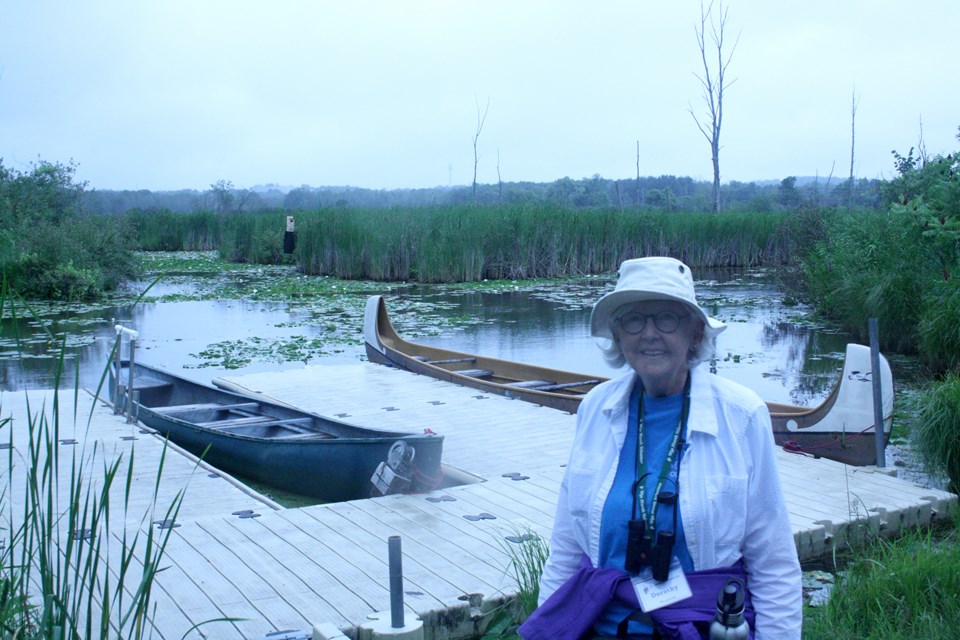As a trail ambassador at the Wye Marsh Wildlife Centre, Dorothy Harper doesn’t just answer questions about the marsh, and its inhabitants, she overflows with a love for nature.
In her role, Harper walks to the busier parts of the marsh, and chats to visitors.
She likes to tell people what she calls ‘Wow facts’ to spark their interest in their surroundings.
As we walked through a cedar grove, Harper demonstrated her ability to elicit a ‘wow’ by
educating me about cedar.
“When the colonists first came from England, they thought come February or March, we’ll start growing things. Instead, we have three feet of snow on the ground until April,” chuckles Harper about the harsh realities of Canadian winters for the unacclimatized.
“A lot of them starved to death and had a lot of vitamin deficiencies. Indigenous people told them to make a tea out of the bark of Eastern White Cedar. You might not think so, but the bark contains a lot of Vitamin C, and it stopped them from getting scurvy.”
The settlers named the tree ‘arborvitae,’ which means tree of life in Latin — a name by which it is still known today.
Harper is full of tidbits like this about natural history, some of which she has gathered in her lengthy career volunteering at the Wye Marsh since 1995.
So vast is her knowledge that she has trained some of the other volunteers who approached us on our walk to praise the naturalist and birder.
Harper comes by her love of nature and birds naturally, of course.
“I’ve been a birder for longer than my time at the marsh,” says the avid birdwatcher, who pointed out the bird board outside the doors at the marsh where visitors can record bird sightings.
As a child, Harper says she was always interested in the natural world, prowling around looking for stuff, she explains. Then later, hiking with her family, her son would turn over rocks to find salamanders carrying on the family tradition of fascination with nature.
Harper became a birder while watching her kids play in their backyard sandbox.
“A bird landed next to me, and I thought it was the most amazing bird. So I got a book, and found out it was a cedar waxwing, and they look very spiffy. Like they’ve got tuxedos on. That got me started.”
Since then, there have been changes in the environment that mean certain birds are more pervasive than they once were, including the bird that adorns the logo for Wye Marsh — the red-winged blackbird.
They love marshlands, and at one time that was where they were mainly found.
“Now, it’s everywhere,” says Harper.
Another bird that’s exploded in population and extended its habitat is the turkey vulture.
Harper explains that this is mostly due to climate change.
“Turkey vultures were often thought of as a bird of North Carolina and Florida, and now here they are, and even up in Sudbury,” says the armchair ornithologist.
Part of the joy in birding is being a citizen scientist.
Harper helps run the Project Feeder Watch program in the winter where people contribute to identifying, tracking and monitoring the winter bird population from the comfort of their own homes.
From November to March, people can participate by recording the birds they see at their own bird feeders, or those set up outside the Wye Marsh visitor centre.
As we continue on our short walk through the marsh, Harper takes me to visit their longest-term resident swan number 93. His wing is broken, and so he’s always at the marsh.
He will never be lonely, because that area of the marsh is bubbled in the winter — meaning air is pushed through the water to prevent ice forming. Keeping this area of the marsh open means that in the winter there can be as many as 90 swans living there at one time.
In answering why she gives of her time to the Wye Marsh, Harper says plainly, “because it’s a drop dead gorgeous environment, and I’m always happy when I’m here.
“To volunteer once a week throughout the summer means you get to see the changes. In breeding season, when all the males are excited, they sing like mad. Then they go silent for about a month. Then the plants are growing. Feeding and seeding. So it’s wonderful. I think it’s worth doing.
“This marsh especially is significant because it’s one of the largest marshes in Ontario, and for what it does for the water.”
The Wye Marsh is a provincially significant wetland, and provides an opportunity for research that will prove vital in preserving other wetlands considering 70 per cent of Canadian wetlands have been lost due to development, farming runoff and invasive species.
Of all the things that Harper shared with me, she wanted everyone to know that the area is not government funded.
“The everyday operation is completely privately funded, so we rely on admissions,” says Harper.
Learn more about the Wye Marsh, and ask really interested bird watchers in blue shirts touring the trails a lot of questions.
“Most birders are more curious and intelligent than the general population,” says Harper with a laugh.
You will learn something new.


